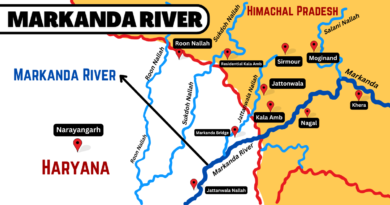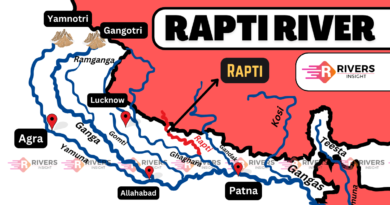Manas River: Map & Origin with Tributaries
Manas River is a transboundary river that flows from the glacier-fed peaks of Tibet through eastern Bhutan and into northeast India, where it merges with the Brahmaputra River. Further, Manas River is Bhutan’s largest river system with a drainage basin covering over 41,350 square kilometres.
Table of Contents
Manas River – Quick Facts
- Alternate Names:
- In China (Tibet): Niamjang
- In Bhutan: Drangme Chhu
- In Arunachal Pradesh (India): Gongri River
- Countries Covered: China, Bhutan, India
- Total Length: Approx. 376 km
- 24 km in China
- 272 km in Bhutan
- 104 km in Assam, India
- Catchment Area: 41,350 sq. km
- Confluence: Brahmaputra River near Jogighopa, Assam
- Major Tributaries: Aie River, Kulong Chu, Kuri Chhu (Lhobrak), Bumthang Chu, Mangde Chhu, Drangme Chhu.
Origin and Course of the Manas River
Manas River system is formed by multiple tributaries, but its main stem (primary source) is considered to originate in southern Tibet, north of the Great Himalayas.
✅ So, the Niamjang Chu in southern Tibet is the true origin of the Manas River system. The river is later strengthened by several large tributaries within Bhutan.
1. In China (Tibet Autonomous Region)
- Name: Niamjang River
- Origin: Southern Tibet, at high Himalayan elevations
- Length in China: ~24 km
- Key Location: It enters India at Bumla Pass in Arunachal Pradesh (northwestern corner)
2. In India (Arunachal Pradesh – Entry Point)
- In West Kameng District, it is known as the Gongri River
- It flows southwest, entering eastern Bhutan near Tashigang
From here, the river system becomes known as the Drangme Chhu, and its full river network develops inside Bhutan.
3. In Bhutan: Formation of the Main River System
Manas River becomes Bhutan’s largest river system, formed by the confluence of multiple major tributaries. It covers 272 km within Bhutan and drains the Tongsa and Bumthang valleys.
Major Tributaries in Bhutan
| Tributary | Origin | Description |
|---|---|---|
| Drangme Chhu | Central Bhutan | Joins at Tashigong where the riverbed is 550 m wide and the elevation is 606 m |
| Mangde Chhu (Tongsa Chu) | Near Kula Kangri Peak | Primary stream forms the backbone of the river system |
| Bumthang Chhu (Murchangphy Chu) | Bumthang Valley | Joins from northeast Bhutan |
| Kulong Chu | Eastern Bhutan | A central tributary that joins downstream from Tongsa Chhu |
| Lhobrak (Kuri Chhu) | Northern Bhutan (beyond Great Himalayas) | Northern Bhutan (beyond the Great Himalayas) |
4. In India (Assam – Final Stretch)
- Entry Point: Enters India again in the Baksa district, Assam
- Major Landmark: Flows through the Manas National Park, a UNESCO World Heritage Site
- Length in Assam: ~104 km
- Terrain: The river emerges into floodplains, forming swamps and marshes in the southern foothills of the Himalayas
- Final Confluence: Merges with the Brahmaputra River at Jogighopa, Assam
Aie River: Key Tributary in Assam
- Origin: Near Bangpari, in the Black Mountains of Bhutan (elevation ~4,915 m)
- Bhutan Flow: ~29 km before entering Assam at Agrong, Goalpara district
- Length in India: ~75 km
- Confluence: Joins the Manas River shortly before it meets the Brahmaputra
- Total Length: ~110 km
Summary Flow Chart
Niamjang River (Tibet, China) → Gongri River (Arunachal Pradesh, India) → Drangme Chhu (Bhutan) → merges with major rivers in Bhutan → Flows as Manas River into Assam, India → joined by Aie River → joins the Brahmaputra River at Jogighopa.
Manas National Park
In Assam, the Manas River flows through Manas National Park, a UNESCO World Heritage Site that is:
- A Project Tiger Reserve
- An Elephant Reserve
- A Biosphere Reserve
Iconic Species Found Here:
- Bengal Tiger
- One-Horned Rhinoceros
- Golden Langur (endemic)
- Asiatic Elephant
- Clouded Leopard
- River Otters
- Over 450 species of birds
The river acts as a biological corridor connecting the Eastern Himalayan ecosystems with the floodplains of the Brahmaputra.
Conclusion
Manas River is not just a river—it’s a biogeographical bridge, a transboundary lifeline, and a symbol of ecological harmony between nations. From the snow-fed heights of Tibet to the floodplains of Assam, it flows through layers of history, culture, and wilderness.
As the largest river system of Bhutan and a major Brahmaputra tributary, the Manas deserves increased awareness, scientific attention, and sustainable preservation.




